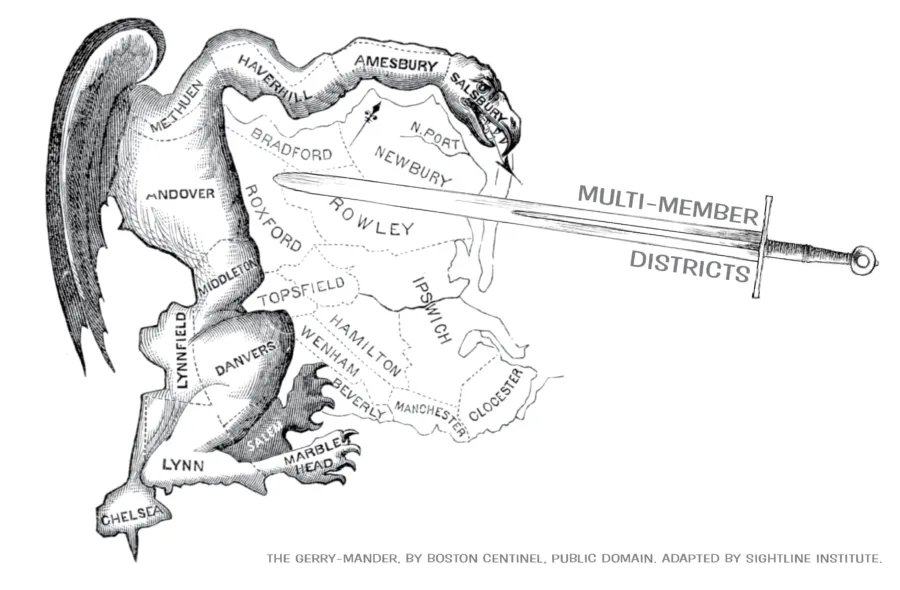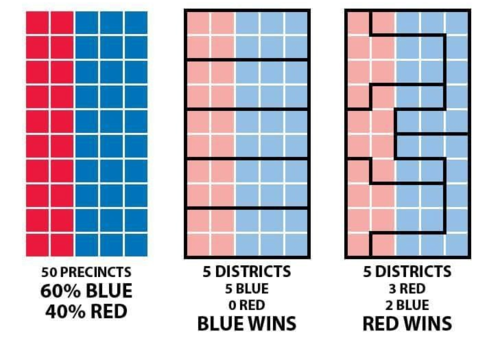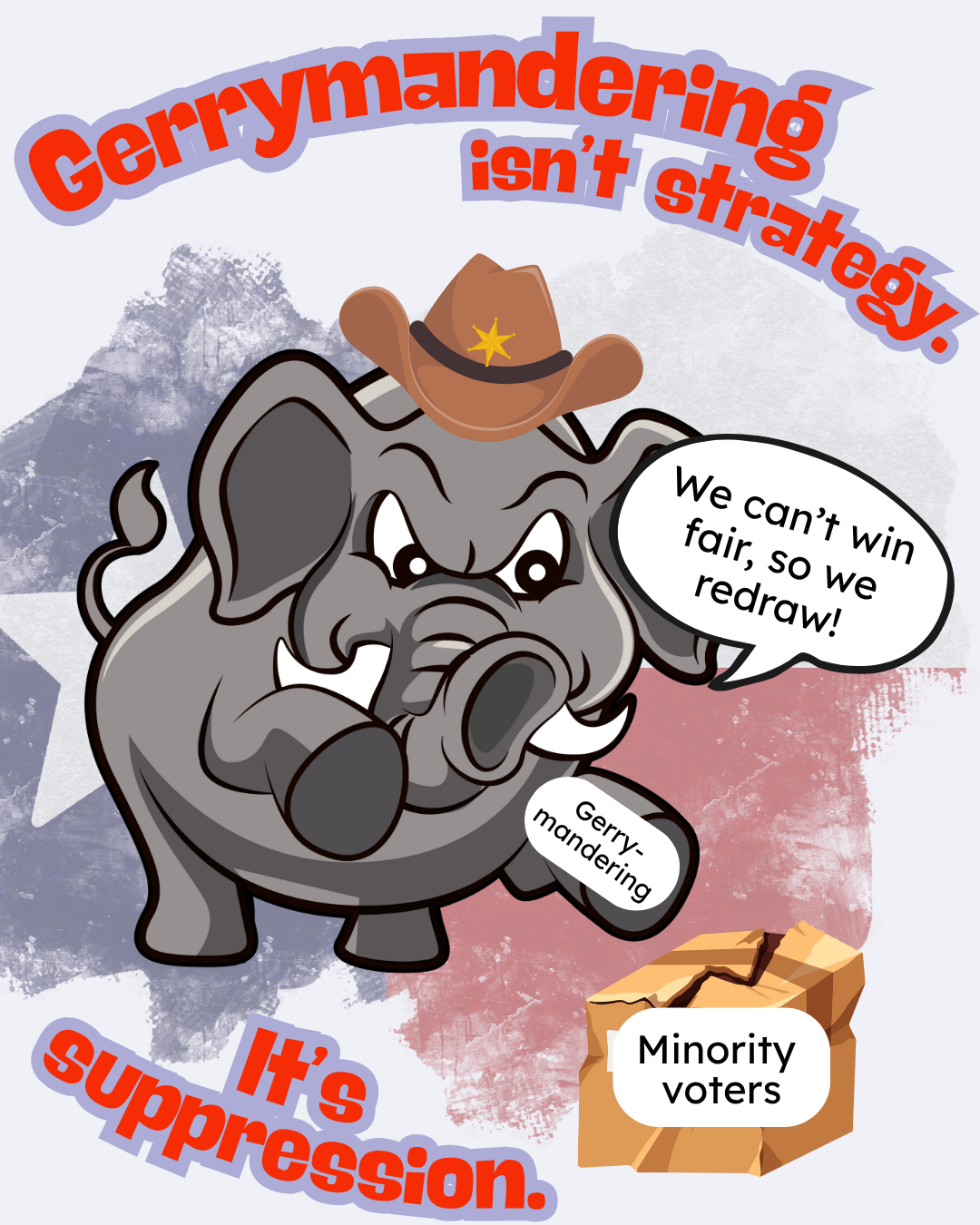Trump Pushing for 5 new GOP Gerrymandered Districts: How to Solve Gerrymandering

Trump Again Undermining Democracy
In yet another blatant attempt to undermine democracy, Donald Trump has reportedly urged Republicans to redraw electoral maps to secure five additional GOP-held seats through a process known as gerrymandering. This cynical ploy is nothing short of authoritarian meddling: a desperate move to manipulate the political system in his favor. Without these handicaps Trump and the GOP know they can't hold onto power. It’s not about representation or fairness—principles Trump has shown he has little regard for—it’s about raw power and control, regardless of the popular will of the people.
The Height of Hypocrisy
Trump’s demand reeks of hypocrisy. He has repeatedly railed against “rigged elections” and claims he's been treated unfairly, but his push for partisan redistricting proves otherwise. By advocating for gerrymandering, Trump shows he’s not interested in fair elections—he’s interested in rigging the system to cling to influence. This should come to no surprise given his attempt to violently overthrow the popularly elected government in 2020. This is the kind of undemocratic behavior typical of autocrats, and Trump fits the mold.
MAGA shows a recurring pattern: accusing opponents of very abuses they themselves commit. In Michigan,Republicans unsuccessfully attempted to get rid of independently drawn districts that came about via voter approved ballot initiatives. Meanwhile in North Carolina, despite the state being evenly split between Republicans and Democrats, gerrymandering has given Republicans 10 congressional seats as opposed to 4 for the opposition. At the federal level, Trump is continuing his attempts to solidify minority rule by gutting civil rights protections that combated gerrymandering techniques historically used to dilute the voting power of Black voters in particular.
Newsom Steps In: A Firm Stand Against Manipulation
California Governor Gavin Newsom has acknowledged the severity of Trump's blatant attempt to gerrymander Texas and responded appropriately. He denounced these efforts to manipulate the democratic process and threatened to do the same in California if necessary.
We live in dire times, and have for a while, as gerrymandering has been the norm longer than it hasn't. Newsom's more forceful stance against MAGA tyranny is a welcome shift from the often futile hope that the GOP might someday prioritize accountability and democratic norms. Tactical responses like this are urgently needed from the opposition. While Newsom’s firm stance is commendable, it underscores the urgent need for bold, national reforms to ensure fair districting. If GOP-controlled states are allowed to draw districts to their advantage, efforts at reform elsewhere risk becoming futile.
California’s Model: Independent Redistricting Commissions
California’s use of independent redistricting commissionsoffers a model for the rest of the country—a process that removes map-drawing from partisan hands and prioritizes fairness over power grabs. This model, along with broader reforms like ranked-choice voting, should be adopted more widely to foster greater competition and give voters an actual choice.

Proposed Reforms to the Redistricting process
In addition to independent distracting commissions, several reforms are being proposed that could make redistricting more democratic and transparent:
- Banning Mid-Decade Redistricting: To prevent parties from redrawing maps whenever they gain control of a state legislature, some proposals, like the federal Redistricting Reform Act of 2024), would prohibit states from engaging in redistricting more than once per census cycle.
- Enhanced Transparency Requirements: Mandating a more open and public process is another key reform. This includes requiring numerous public hearings before and after draft maps are created, releasing the data and software used for redistricting, and allowing citizens to draw and submit their own maps for consideration. Learn more here
Criteria-Based Reforms
- Mandating Objective and Neutral Criteria: Federal and state legislation can establish specific, legally enforceable criteria that all district maps must follow. These often include:
- Contiguity: All parts of a district are physically connected.
- Compactness: Districts should be geographically compact and avoid sprawling, bizarre shapes. This can be measured using mathematical formulas like the isoperimetric quotient or the ratio of the district's area to a convex polygon drawn around it.
- Preservation of Political Subdivisions: Minimize the splitting of counties, cities, and towns.
- Communities of Interest: Keep together groups of people with common social or economic interests.
Learn about some of these reform that were attempted in North Carolina.
Systemic Electoral Reforms
- Proportional Representation and Multi-Member Districts: A fundamental way to eliminate the impact of gerrymandering is to move from single-member, winner-take-all districts to a system of proportional representation. In this model:
- States would have larger, multi-member districts where several candidates are elected.
- Seats would be allocated based on the percentage of the vote each party receives within that district. For example, if a party wins 40% of the vote in a five-member district, they would win two of the five seats.
- This makes it nearly impossible to gerrymander because even if a party's voters are "cracked" or "packed," they will still contribute to their party's overall vote share and help elect a proportionate number of representatives.
- Learn more from FairVote and Represent Us
- Ranked-Choice Voting (RCV): Used in conjunction with multi-member districts, RCV can further enhance fairness. Voters rank candidates in order of preference. If no candidate wins a majority outright, the candidate with the fewest votes is eliminated, and their voters' second choices are distributed to the remaining candidates. This process continues until a winner is determined. Proponents argue this encourages candidates to appeal to a broader base of voters. Ranked-Choice Voting is already used in a number of well functioning democracies
- Mixed-Member Proportional Representation (MMP): This hybrid system, also known as "Districts Plus", combines single-member districts with "accountability seats" or "top-up seats". Most legislators are elected from traditional districts, but additional seats are awarded to parties based on their statewide vote share to ensure the final composition of the legislature is proportional to the overall vote.
Conclusion
Trump's call to manipulate elections by gerrymandering is entirely in character, and reflects exactly what his movement is all about. While Newsom fighting back is necessary, it must be paired with deeper reforms. We need to move beyond reactive politics and commit to transforming how power is distributed in our electoral system. Let's keep gerrymandering where it belongs in the history books, and continue demanding systems that reflect the true will of the people. Stay engaged in the conversation around elections, and pay close attention as we head into the midterms.

